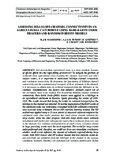Assessing hillslope-channel connectivity in an agricultural catchment using rare-earth oxide tracers and random forests models
Fecha
2017Autor
Versión
Acceso abierto / Sarbide irekia
Tipo
Artículo / Artikulua
Versión
Versión publicada / Argitaratu den bertsioa
Impacto
|
|
10.18172/cig.3169
Resumen
Soil erosion from agricultural areas is a large problem because of off-site effects like the rapid filling of reservoirs. To mitigate the problem of sediments from agricultural areas reaching the channel, reservoirs and other surface areas it is important to understand hillslope-channel connectivity and catchment connectivity. To determine the functioning of hillslope-channel connectivity and the ...
[++]
Soil erosion from agricultural areas is a large problem because of off-site effects like the rapid filling of reservoirs. To mitigate the problem of sediments from agricultural areas reaching the channel, reservoirs and other surface areas it is important to understand hillslope-channel connectivity and catchment connectivity. To determine the functioning of hillslope-channel connectivity and the continuation of transport of these sediments in the channel, it is necessary to obtain data on sediment transport from the hillslopes to the channels. Simultaneously, the factors that influence sediment export out of the catchment need to be studied. For measuring hillslope-channel sediment connectivity, rare-earth oxide (REO) tracers were applied to a hillslope in an agricultural catchment in Navarre, Spain, preceding the winter of 2014-2015. The results showed that during the winter no sediment transport from the hillslope to the channel was detected. To test the implication of the REO results at the catchment scale, two contrasting conceptual models for sediment connectivity were assessed using a random forest (RF) machine learning method. The RF method was applied using a 15-year period of measured sediment output at the catchment scale. One model proposes that small events provide sediment for large events, while the other proposes that only large events cause sediment detachment and small events subsequently remove these sediments from near and in the channel. For sediment yield prediction of small events, variables related to large preceding events were the most important. The model for large events underperformed and, therefore, we could not draw any immediate conclusions whether small events influence the amount of sediment exported during large events. Both REO tracers and RF method showed that low intensity events do not contribute any sediments from the hillslopes to the channel in Latxaga catchment. Sediment dynamics are dominated by sediment mobilization during large (high intensity) events. Sediments are for a large part exported during those events, but the system shows a memory of the occurrence of these large events, suggesting that large amounts of sediments are deposited in and near the channel after these events. These sediments are gradually removed by small events. To better understand the delivery if sediments to the channel and how large and small events influence each other, more field data on hillslope-channel connectivity and within-channel sediment dynamics is necessary. [--]
Materias
Trazadores de sedimentos,
Selvas aleatorias,
Mediterráneo,
Conectividad ladera-cauce,
Sediment tracing,
Random forests,
Mediterranean,
Hillslope-channel connectivity
Editor
Universidad de la Rioja
Publicado en
Cuadernos de Investigación Geográfica 2017, nº 43 (1), pp. 19-39
Departamento
Universidad Pública de Navarra. Departamento de Proyectos e Ingeniería Rural /
Nafarroako Unibertsitate Publikoa. Landa Ingeniaritza eta Proiektuak Saila /
Universidad Pública de Navarra/Nafarroako Unibertsitate Publikoa. Institute on Innovation and Sustainable Development in Food Chain - ISFOOD
Versión del editor
Entidades Financiadoras
This study was funded by the Dutch Organization for Scientific Research (NWO), grant number 822.01.004, The Spanish Ministry of Science and Innovation, project CGL2015-64284-C2-1-R (MINECO-FEDER) and COST action ES 1306.







